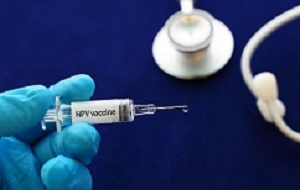 Girls in the first birth cohort to receive the HPV vaccine showed a lower degree of dysplasia which may eventually lead to cervical cancer than a birth cohort from 1983, found the first study of the vaccine's effect on the general population. This is the conclusion of a study conducted by researchers at the University of Copenhagen.
Girls in the first birth cohort to receive the HPV vaccine showed a lower degree of dysplasia which may eventually lead to cervical cancer than a birth cohort from 1983, found the first study of the vaccine's effect on the general population. This is the conclusion of a study conducted by researchers at the University of Copenhagen.
The effects of the HPV vaccine, which in 2009 became part of the Danish childhood vaccination programme, have been examined by researchers from the faculty of health and medical sciences at the University of Copenhagen. And the conclusion is unmistakable: The HPV vaccine works.
The new study is the first to examine the effect of the vaccine in the population at large, say Professor Elsebeth Lynge and PhD student Lise Thamsborg from the department of public health, University of Copenhagen.
“It is the first study in the world to test the Gardasil-4 vaccine on a population level. The childhood vaccination programme, which includes the HPV vaccine, is targeted at the entire population. Therefore, it is important to look at the entire population and the effect of the vaccine after the first screening of women aged 23 years,” says Professor Elsebeth Lynge, last author of the study.
The researchers have looked at the 1993 birth cohort, which was the first birth cohort to be offered the vaccine. They have then compared it to a 1983 birth cohort, who have not been offered HPV-vaccination. The two birth cohorts of women are comparable and resemble each other as regards level of education and average age of sexual debut, among other things.
The researchers have then examined the results of the women's first cervical screening test. The 1993 birth cohort was invited to a screening test in 2016, while women born in 1983 had their first screening test in 2006, before the vaccine was marketed. The researchers discovered a significantly reduced risk of severe dysplasia in the 1993 birth cohort compared to the 1983 birth cohort. To be precise, the risk was reduced by 40%.
“This means that fewer women have to be referred to a gynaecologist for further examination and have a tissue sample taken. Eventually we also expect fewer to fall ill”, says Thamsborg.
The girls from the 1993 birth cohort were 15 years old when they received the vaccine. And the researchers expect the effect to be even more pronounced today, where girls are offered the vaccine already at the age of 12.
“It is better. We expect the effect to be greater among those vaccinated at the age of 12, because very few have been sexually active at this age”, says Thamsborg.
However, the study did not only find a reduction in severe dysplasia. Contrary to expectation – and from what randomised trials have shown – the women born in 1993 showed a higher level of mild dysplasia than the women born in 1983. In 2006, though, new technology was introduced for examining the cell samples that reveal cases of dysplasia. This may be the cause of the increase in cases of mild dysplasia, the researchers believe.
“The new technology has led to fewer inadequate samples, and the samples are of a higher quality today. So, the samples are more sensitive. This may be the cause,” says Thamsborg.
The next step for the researchers is to examine the tissue samples taken from women with dysplasia. The aim is to learn whether and, if so, how cases of mild and severe dysplasia, respectively, have developed.
If a woman suffers from severe dysplasia, a tissue sample is taken. It can reveal precursor lesions to cervical cancer. There are different levels of these precursor lesions. If a woman shows mild dysplasia, she is invited to a control typically six months later to see whether the changes have stopped or developed further.
Abstract
4vHPV‐vaccination has been tested in randomized controlled trials under almost ideal conditions, and studies of real‐life use have compared outcome between vaccinated and unvaccinated women from the same birth cohort and mostly before screening age.
Here we present the first ‐ to our knowledge ‐ evaluation of the impact of the 4vHPV‐vaccination in real‐life without selection bias in the reported data.
The study has been carried out by comparing the results after first cervical screening between an HPV‐vaccinated and an unvaccinated birth cohort, consisting of women born in Denmark in 1993 and 1983, respectively. Cytology data covering an 8‐year period, from the age of 15 (age of HPV‐vaccination) to age 23 (age of invitation to first cervical screening), were retrieved from the Danish National Pathology Register.
Abnormal cytology, defined as atypical squamous cell of undetermined significance and worse (ASCUS+) was detected in 9.4% of women born in 1993 as compared with 9.0% of women born in 1983; RR = 1.04 (95% CI 0.96–1.12), p = 0.29.
Detection of high grade squamous intraepithelial lesion (HSIL) was statistically significantly lower in the 1993 than in the 1983 cohort, RR = 0.6 (95% CI 0.5‐0.7), p <0.0001, while the opposite pattern was seen for ASCUS RR = 1.4 (95% CI 1.2–1.6), p <0.0001.
The decrease in HSIL means that more women can be spared referral for colposcopy and biopsy. The increase of ASCUS could be explained by transition from conventional to liquid‐based cytology, but this observation requires further monitoring.
Authors
Lise Holst Thamsborg, George Napolitano, Lise Grupe Larsen, Elsebeth Lynge
[link url="https://www.sciencedaily.com/releases/2018/06/180618102528.htm"]University of Copenhagen material[/link]
[link url="https://onlinelibrary.wiley.com/doi/abs/10.1002/ijc.31568"]International Journal of Cancer abstract[/link]
